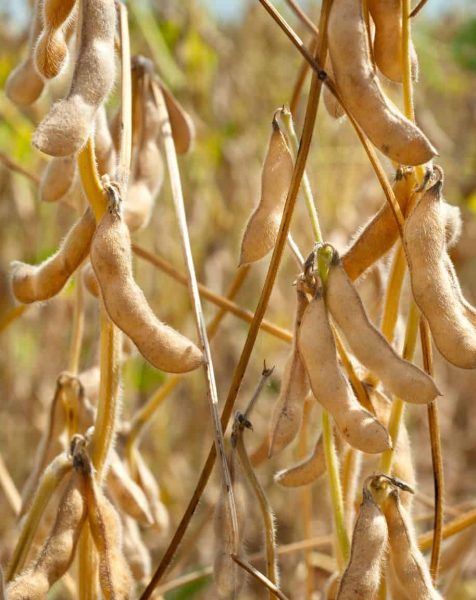Understanding Soybean Yields and the Components Driving Them

By: John Fisher
Understanding Soybean Pod Abortion
- number of seeds, and
- average seed weight (seed size).
Understanding how soybean plants regulate seed number in response to stress gives us insight on how to preserve soybean yields. This knowledge, paired with the appropriate crop management tools, gives us a distinct advantage to combat yield loss. Soybean seed number, one of the key yield components mentioned above, is determined by the number of flowers produced, the number of pods retained on the plant, and the number of seeds per pod.
Flowers on soybean plants can be produced on all stem and branch nodes, and the flower number is highly influenced by the amount of branching. The number of branches and branch length are amazingly flexible and respond to stand density and plant spacing. The flowers produced are “complete flowers” which means that they contain all four basic flower parts: sepals, petals, stamens, and pistil. The structure of a soybean flower ensures that 98% of soybean pods result from self-pollination, which produces two to three times more flowers than there will be pods at harvest. This excess capacity is part of a strategy to produce viable seeds even if stress causes flowers to abscise.
Abscission is an important process that controls pod load (and seed number) on soybean plants. Poor growth conditions including drought stress, shading by weeds, leaf defoliation and even long periods of clouds increase the amount of abscission. But, even under excellent growing conditions, abscission of 50% or more of the flowers is normal. Since nearly 100% of soybean flowers are fertilized, the decrease in the number of pods is due to pod abortion that occurs after the flowers have been fertilized.
Understanding Soybean Seed Abortion
Immediately after fertilization of the ovules in the ovary, the pod wall begins to expand and is almost complete by the time seed filling begins. When pod wall growth is finished, developing seeds have obtained only about 5% of their final dry weight.
In a normal pod with normally developing seeds, the seeds at stage R6 will almost completely fill the pod cavity. The number of seeds in a pod is determined by number of ovules in the ovary, the number of those ovules fertilized, and the number of seeds that continue development until maturity.
Successful fertilization of an ovule does not mean that the resulting seed will continue development through maturity – seed abortion may occur to any of the growing seeds. It is common to have 10 to 20% of fertilized seeds abort with more than 90% of the abortion incidences occurring within 30 days of fertilization.
During seed development, seeds require a steady flow of water, carbohydrates, and mineral nutrients. Any stress that reduces any of these requirements may increase the rate of seed abortion. Since seeds are most vulnerable to abortion early in their development, stress during growth stage R4 is more likely to reduce seed number per pod than stresses that occur earlier or later in the growing season. Managing and developing soybean plants that can withstand various stressors during important growth stages is critical to reducing the amount of pod and seed abortion, therefore preserving yield.
Soybean Pod and Seed Abortion Management with BioLiNE® Technology
BioLiNE’s Biogenic Nutrient Accelerator™ (BNA) technology drastically improves the transport and assimilation of nutrients and other plant beneficial compounds. Combining superior cell permeability, bioactive chemistry, and accelerated nutrient exchange is our advantage. Our technology is an effective crop management tool that armors soybean crops against stress-induced seed and pod abortions. BioLiNE® technology can be applied at three different reproductive stages in the development of soybean crops including:
- R1 Stage – To help reduce Pod Abortion;
- R3 Stage – To help reduce Seed Abortion; and
- R5 Stage – To help increase seed sizing.
